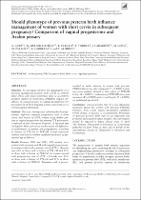| dc.contributor | Vall d'Hebron Barcelona Hospital Campus |
| dc.contributor.author | Care, A. |
| dc.contributor.author | Muller‐Myhsok, B. |
| dc.contributor.author | Olearo, E. |
| dc.contributor.author | Todros, T. |
| dc.contributor.author | Caradeux, J. |
| dc.contributor.author | Goya Canino, Maria del Mar |
| dc.contributor.author | Carreras Moratonas, Elena |
| dc.date.accessioned | 2021-04-08T10:59:26Z |
| dc.date.available | 2021-04-08T10:59:26Z |
| dc.date.issued | 2019-04 |
| dc.identifier.citation | Care A, Muller‐Myhsok B, Olearo E, Todros T, Caradeux J, Goya M, et al. Should phenotype of previous preterm birth influence management of women with short cervix in subsequent pregnancy? Comparison of vaginal progesterone and Arabin pessary. Ultrasound Obstet Gynecol. 2019 Apr;53(4):529–34. |
| dc.identifier.issn | 1469-0705 |
| dc.identifier.uri | https://hdl.handle.net/11351/5831 |
| dc.description | Pessari Arabin; Coll uterí curt; Progesterona vaginal |
| dc.language.iso | eng |
| dc.publisher | John Wiley and Sons |
| dc.relation.ispartofseries | Ultrasound in Obstetrics and Gynecology;53(4) |
| dc.rights | Attribution-NonCommercial 4.0 International |
| dc.rights.uri | http://creativecommons.org/licenses/by-nc/4.0/ |
| dc.source | Scientia |
| dc.subject | Membranes fetals |
| dc.subject | Part prematur |
| dc.subject | Coll uterí |
| dc.subject.mesh | Fetal Membranes, Premature Rupture |
| dc.subject.mesh | /prevention & control |
| dc.subject.mesh | Cervical Length Measurement |
| dc.subject.mesh | Premature Birth |
| dc.title | Should phenotype of previous preterm birth influence management of women with short cervix in subsequent pregnancy? Comparison of vaginal progesterone and Arabin pessary |
| dc.type | info:eu-repo/semantics/article |
| dc.identifier.doi | 10.1002/uog.19118 |
| dc.subject.decs | rotura prematura de las membranas fetales |
| dc.subject.decs | /prevención & control |
| dc.subject.decs | medida de la longitud del cuello uterino |
| dc.subject.decs | parto prematuro |
| dc.relation.publishversion | https://obgyn.onlinelibrary.wiley.com/doi/full/10.1002/uog.19118 |
| dc.type.version | info:eu-repo/semantics/publishedVersion |
| dc.audience | Professionals |
| dc.contributor.organismes | Institut Català de la Salut |
| dc.contributor.authoraffiliation | [Care A] Harris Wellbeing Preterm Birth Centre, Department of Women and Children's Health Research, Liverpool Women's Hospital, Liverpool, UK. [Muller-Myhsok B] Waterhouse Building, University of Liverpool, Liverpool, UK. Max Plank Institute of Psychiatry, Munich, Germany. [Olearo E, Todros T] Obstetrics and Gynecology Unit 2, Department of Surgical Sciences, University of Turin, Turin, Italy. [Caradeux J] Barcelona Center for Maternal-Fetal and Neonatal Medicine (Hospital Clínic and Hospital Sant Joan de Déu), University of Barcelona, Barcelona, Spain. [Goya M, Carreras E] Servei d'Obstetrícia, Vall d'Hebron Hospital Universitari, Barcelona, Spain. Universitat Autònoma de Barcelona, Bellaterra, Spain |
| dc.identifier.pmid | 29920812 |
| dc.identifier.wos | 000463145000015 |
| dc.rights.accessrights | info:eu-repo/semantics/openAccess |

